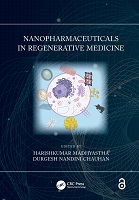Chapter 8 Hyaluronan-Based Hydrogels as Functional Vectors for Standardised Therapeutics in Tissue Engineering and Regenerative Medicine
Proposal review
| dc.contributor.author | Porcello, Alexandre | |
| dc.contributor.author | Laurent, Alexis | |
| dc.contributor.author | Hirt-Burri, Nathalie | |
| dc.contributor.author | Abdel-Sayed, Philippe | |
| dc.contributor.author | de Buys Roessingh, Anthony | |
| dc.contributor.author | Raffoul, Wassim | |
| dc.contributor.author | Jordan, Olivier | |
| dc.contributor.author | Allémann, Eric | |
| dc.contributor.author | Applegate, Lee Ann | |
| dc.date.accessioned | 2023-09-27T12:59:58Z | |
| dc.date.available | 2023-09-27T12:59:58Z | |
| dc.date.issued | 2022 | |
| dc.identifier.uri | https://library.oapen.org/handle/20.500.12657/76457 | |
| dc.description.abstract | Hyaluronan-based hydrogels are optimal candidates when developing novel combined advanced therapy medicinal products (cATMP), tissue engineering products (TEP), and medical devices. The key physico-chemical properties of hydrogels may hinder, mediate, or stimulate therapeutic potentials borne by standardised cellular substrates in regenerative medicine. Parallel to delivery system or scaffold development, hydrogel functionalisation may be advantageous in specific musculoskeletal interventions or topical applications (e.g. viscosupplementation, soft tissue volumetric supplementation, rehabilitation topical preparations). Optimised combination product developmental workflows enable pragmatic regulatory classification of cell-based preparations. Such aspects will be discussed, as well as sustainable transposition to industrialised production settings. Hyaluronan benefits from extensive hindsight in numerous human and veterinary applications, providing a highly versatile backbone for quasi-infinite structural modification and physico-chemical property modulation. This chapter provides an overview of critical product design considerations and possible therapeutic applications of versatile hyaluronan-based preparations intended for cell therapy delivery, combined with optimised autologous or allogeneic therapeutic cell sources (e.g. platelet-rich plasma, stem cells, banked primary foetal progenitors). Particular focus was set on specific parameters directly impacting product potential in terms of clinical translation and effectiveness for topical wound healing or sub-critical volumetric defect correction and repair stimulation in musculoskeletal regenerative medicine applications. | en_US |
| dc.language | English | en_US |
| dc.subject.other | Regenerative medicine, Carbon nanotube, Block copolymers, Wound healing, Anticancer therapy, Particles used in imaging | en_US |
| dc.title | Chapter 8 Hyaluronan-Based Hydrogels as Functional Vectors for Standardised Therapeutics in Tissue Engineering and Regenerative Medicine | en_US |
| dc.type | chapter | |
| oapen.identifier.doi | 10.1201/9781003153504-8 | en_US |
| oapen.relation.isPublishedBy | 7b3c7b10-5b1e-40b3-860e-c6dd5197f0bb | en_US |
| oapen.relation.isPartOfBook | 5d8d853c-fc22-4e77-a709-a1d951e52343 | en_US |
| oapen.relation.isbn | 9780367721138 | en_US |
| oapen.relation.isbn | 9780367721169 | en_US |
| oapen.imprint | CRC Press | en_US |
| oapen.pages | 31 | en_US |
| peerreview.anonymity | Single-anonymised | |
| peerreview.id | bc80075c-96cc-4740-a9f3-a234bc2598f1 | |
| peerreview.open.review | No | |
| peerreview.publish.responsibility | Publisher | |
| peerreview.review.stage | Pre-publication | |
| peerreview.review.type | Proposal | |
| peerreview.reviewer.type | Internal editor | |
| peerreview.reviewer.type | External peer reviewer | |
| peerreview.title | Proposal review | |
| oapen.review.comments | Taylor & Francis open access titles are reviewed as a minimum at proposal stage by at least two external peer reviewers and an internal editor (additional reviews may be sought and additional content reviewed as required). |

